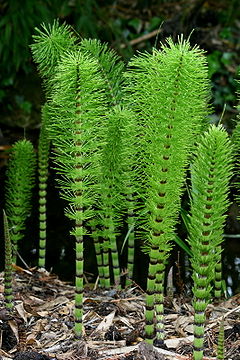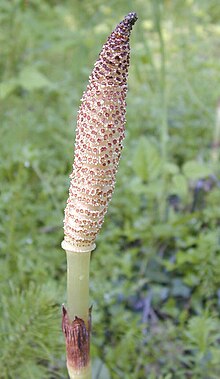Equisetum
| Equisetaceae Temporal range: Late Devonian-Recent
| |
|---|---|

| |
| "Candocks" of the Great Horsetail (Equisetum telmateia telmateia), showing whorls of branches and the tiny dark-tipped leaves | |
| Scientific classification | |
| Kingdom: | |
| Division: | |
| Class: | |
| Order: | |
| Family: | Equisetaceae
|
| Genera | |
|
Equisetum | |
Equisetum (Template:Pron-en)[1] is the only living genus in the Equisetaceae, a family of vascular plants that reproduce by spores rather than seeds. They are commonly known as horsetails.
Equisetum is a "living fossil," as it is the only known genus of the entire class Equisetopsida, which for over one hundred million years was very diverse and dominated the understory of late Paleozoic forests. Some Equisetopsida were large trees reaching to 30 meters tall;[2] the genus Calamites of family Calamitaceae for example is abundant in coal deposits from the Carboniferous period.
A superficially similar but entirely unrelated flowering plant genus, mare's tail (Hippuris), is occasionally misidentified and misnamed as "horsetail".
Etymology

The small white protuberances are accumulated silicates on cells.
The name "horsetail", often used for the entire group, arose because the branched species somewhat resemble a horse's tail. Similarly, the scientific name Equisetum derives from the Latin equus ("horse") + seta ("bristle").
Other names include candock for branching individuals, and scouring-rush for unbranched or sparsely branched individuals. The latter name refers to the plants' rush-like appearance, and to the fact that the stems are coated with abrasive silicates, making them useful for scouring (cleaning) metal items such as cooking pots or drinking mugs, particularly those made of tin. In German, the corresponding name is Zinnkraut ("tin-herb"). Rough Horsetail E. hyemale is still boiled and then dried in Japan, to be used for the final polishing process on woodcraft to produce a smoother finish than any sandpaper.
Distribution and ecology
The genus Equisetum is near-cosmopolitan, being absent only from Australasia and Antarctica. They are perennial plants, either herbaceous and dying back in winter as most temperate species, or evergreen as most tropical species and the temperate species Rough Horsetail (E. hyemale), Branched Horsetail (E. ramosissimum), Dwarf Horsetail (E. scirpoides) and Variegated Horsetail (E. variegatum). They mostly grow 0.2-1.5 m tall, though the "giant horsetail" are recorded to grow as high as 2.5 m (Northern Giant Horsetail, E. telmateia), 5 m (Southern Giant Horsetail, E. giganteum) or 8 m (Mexican Giant Horsetail, E. myriochaetum), and allegedly even more[3].
Many plants in this genus prefer wet sandy soils, though some are semi-aquatic and others are adapted to wet clay soils. The stalks arise from rhizomes that are deep underground and almost impossible to dig out. The Field Horsetail (E. arvense) can be a nuisance weed, readily regrowing from the rhizome after being pulled out. It is also unaffected by many herbicides designed to kill seed plants, however, as E. arvense prefers an acid soil, lime may be used to assist in eradication efforts to bring the soil pH to 7 or 8.[4]

B = branch in whorl
I = internode
L = leaves
N = node
If eaten in large quantities, the foliage of some species is poisonous to grazing animals, including (somewhat ironically given its common name) horses[5]. On the other hand some species[verification needed] are cooked and eaten by humans in Japan.
Anatomy

In these plants the leaves are greatly reduced and usually non-photosynthetic. They contain a single, non-branching vascular trace, which is the defining feature of microphylls. However, it has recently been recognised that horsetail microphylls are probably not primitive like in Lycopodiophyta (clubmosses and relatives), but rather advanced adaptations, evolved by the reduction of a megaphyll[6]. They are therefore sometimes actually referred to as megaphylls to reflect this homology.
The leaves of horsetails grow in whorls fused into nodal sheaths. The stems are green and photosynthetic, and distinctive in being hollow, jointed and ridged (with sometimes 3 but usually 6-40 ridges). There may or may not be whorls of branches at the nodes; when present, these branches are identical to the main stem except being smaller and more delicate.
Spores
The spores are borne under sporangiophores in strobili, cone-like structures at the tips of some of the stems. In many species the cone-bearing stems are unbranched, and in some (e.g. Field Horsetail, E. arvense) they are non-photosynthetic, produced early in spring separately from photosynthetic sterile stems. In some other species (e.g. Marsh Horsetail, E. palustre) they are very similar to sterile stems, photosynthetic and with whorls of branches.
Horsetails are mostly homosporous, though in the Field Horsetail smaller spores give rise to male prothalli. The spores have four elaters that act as moisture-sensitive springs, assisting spore dispersal after the sporangia have split open longitudinally.
Evolution and systematics
The Equisetopsida were formerly regarded as a separate division of spore plants and also called Arthrophyta or Sphenophyta; today they have been recognized as rather close relatives of the typical ferns (Pteridopsida) and form a specialized lineage of the Pteridophyta.[7]
As mentioned above, all living horsetails are placed in the genus Equisetum. But there are some fossil species that are not assignable to the modern genus:
- Pseudobornia contains the oldest known Equisetaceae[verification needed]; it grew in the late Devonian, about 375 million years ago.
- Equisetites is a "wastebin taxon" uniting all sorts of large horsetails from the Mesozoic; it is almost certainly paraphyletic and would probably warrant to be subsumed in Equisetum. But while some of the species placed there are likely to be ancestral to the modern horsetails, there have been reports of secondary growth in other Equisetites, and these probably represent a distinct and now-extinct horsetail lineage. Equicalastrobus is the name given to fossil horsetail strobili, which probably mostly or completely belong to the (sterile) plants placed in Equisetites.[8]
Species
The living members of the genus Equisetum are divided into two distinct lineages, which are treated as subgenera. Hybridogenic species are common, but such hybridization has only been recorded between members of the same subgenus.[9]
In addition, there are numerous ill-determined populations. One of them, the Kamchatka Horsetail ("Equisetum camtschatcense"[verification needed]), is an ornamental forming imposing stands of these archaic plants.

- Subgenus Equisetum
- Equisetum arvense L. - Field Horsetail, Common Horsetail or "giant horsetail"
- Equisetum bogotense Kunth - Andean Horsetail or "giant horsetail"
- Equisetum diffusum L. - Himalayan Horsetail
- Equisetum fluviatile L. - Water Horsetail
- Equisetum palustre L. - Marsh Horsetail
- Equisetum pratense Ehrh. - Meadow Horsetail, Shade Horsetail, Shady Horsetail
- Equisetum sylvaticum L. - Wood Horsetail
- Equisetum telmateia Ehrh. - Great Horsetail, Northern Giant Horsetail

- Subgenus Hippochaete
- Equisetum giganteum L. - Southern Giant Horsetail or "giant horsetail"
- Equisetum myriochaetum Schlect. & Cham. - Mexican Giant Horsetail or "giant horsetail"
- Equisetum hyemale L. - Rough Horsetail, Scouringrush Horsetail
- Equisetum laevigatum A. Braun - Smooth Horsetail
- Equisetum ramosissimum Desf. - Branched Horsetail
- Equisetum scirpoides Michx. - Dwarf Horsetail
- Equisetum variegatum Schleich. ex Weber & Mohr - Variegated Horsetail
Named hybrids

- Hybrids between species in subgenus Equisetum
- Equisetum × bowmanii C.N.Page (Equisetum sylvaticum × Equisetum telmateia)
- Equisetum × dycei C.N.Page (Equisetum fluviatile × Equisetum palustre)
- Equisetum × font-queri Rothm. (Equisetum palustre × Equisetum telmateia)
- Equisetum × litorale Kühlew ex Rupr. (Equisetum arvense × Equisetum fluviatile)
- Equisetum × mildeanum Rothm. (Equisetum pratense × Equisetum sylvaticum)
- Equisetum × robertsii Dines (Equisetum arvense × Equisetum telmateia)
- Equisetum × rothmaleri C.N.Page (Equisetum arvense × Equisetum palustre)
- Equisetum × willmotii C.N.Page (Equisetum fluviatile × Equisetum telmateia)
- Hybrids between species in subgenus Hippochaete
- Equisetum × ferrissii Clute (Equisetum hyemale × Equisetum laevigatum)
- Equisetum × moorei Newman (Equisetum hyemale × Equisetum ramosissimum)
- Equisetum × nelsonii (A.A.Eat.) Schaffn. (Equisetum laevigatum × Equisetum variegatum)
- Equisetum × schaffneri Milde (Equisetum giganteum × Equisetum myriochaetum)
- Equisetum × trachydon A.Braun (Equisetum hyemale × Equisetum variegatum)
Spring delicacy
The strobili are highly appreciated as a spring delicacy. After removing the bitterness they are eaten in Japan where they are called tsukushi.
Other uses
The leaves are used as a dye and give a soft green colour.
Its extract is often used to provide silica for supplementation.
See also
Footnotes
- ^ Sunset Western Garden Book, 1995:606–607
- ^ "An Introduction to the Genus Equisetum and the Class Sphenopsida as a whole". Florida International University. Retrieved 2009-07-22.
- ^ Husby (2003)
- ^ Henriette Kress, Getting rid of horsetail, Henriette's Herbal Homepage.[1]
- ^ Israelsen et al. (2006)
- ^ Rutishauser (1999)
- ^ Pryer et al. (2004), Smith et al. (2006)
- ^ Weber (2005)
- ^ Pigott (2001)
References
- Husby, Chad E. (2003): How large are the giant horsetails? Version of 2003-MAR-19. Retrieved 2008-NOV-20.
- Israelsen, Clark E.; McKendrick, Scott S. & Bagley, Clell V. (2006): Poisonous Plants and Equine. PDF fulltext
- Pigott, Anthony (2001): National Collection of Equisetum – Summary of Equisetum Taxonomy. Version of 2001-OCT-04. Retrieved 2008-NOV-20.
- Pryer, K.M.; Schuettpelz, E.; Wolf, P.G.; Schneider, H.; Smith, A.R. & Cranfill, R. (2004): Phylogeny and evolution of ferns (monilophytes) with a focus on the early leptosporangiate divergences. Am. J. Bot. 91(10): 1582-1598. PDF fulltext
- Rutishauser, Rolf (1999): Polymerous Leaf Whorls in Vascular Plants: Developmental Morphology and Fuzziness of Organ Identities. International Journal of Plant Sciences 160(Supplement 6): 81–103. doi:10.1086/314221 PDF fulltext
- Smith, Alan R.; Pryer, Kathleen M.; Schuettpelz, Eric; Korall, Petra; Schneider, Harald & Wolf, Paul G. (2006): A classification for extant ferns. Taxon 55(3): 705-731. doi:10.1086/314221 PDF fulltext
- Weber, Reinhard (2005): Equisetites aequecaliginosus sp. nov., ein Riesenschachtelhalm aus der spättriassischen Formation Santa Clara, Sonora, Mexiko [Equisetites aequecaliginosus sp. nov., a tall horsetail from the Late Triassic Santa Clara Formation, Sonora, Mexico]. Revue de Paléobiologie 24(1): 331-364 [German with English abstract]. PDf fulltext
External links
- The Wonderful World of Equisetum
- HDRA Organic Weed Management: Field horsetail - includes Occurrence, Biology, Persistence and Spread, Management and Discussion
- Equisetum hyemale L., scouringrush horsetail
- National Collection of Equisetum
